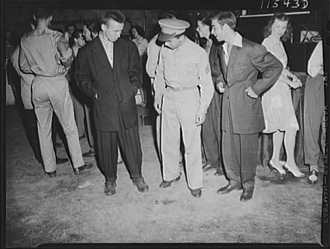Kathy Peiss
Zoot Suit: The Enigmatic Career of an Extreme Style
University of Pennsylvania Press
240 pages, 6 x 9 inches
ISBN 978 0812243376
Zoot Suit is a history of one of the most famous “street styles” of the 20th century. With its broad shoulders, tapered long jacket, pegged pants, and swinging key chain, this extreme male fashion caught the imagination of many young Americans in the World War II era. As the United States mobilized for war, it also became a highly controversial style, especially as civil unrest broke out in Los Angeles in 1943, known to this day as the “zoot suit riot.”
In my book, I explore what this exaggerated fashion meant in the war years and after. I show how this style took hold among young men, circulated rapidly in the popular culture, and then became caught up in the racial politics of the home front. As it did so, the zoot suit became a symbol, but an enigmatic one. The style eluded the efforts of experts and academics to fix its meaning—then and now.
The zoot suit started in the streets and dancehalls of Harlem and spread rapidly around the country. Those who wore the zoot suit loved its spectacular look, how it moved on the body, and the way it drew public attention. It was especially popular among African Americans and Mexican Americans (known as pachucos), but young men of Filipino, Japanese, Jewish, and Italian background also embraced the style. It appealed to middle-class jitterbugging teens, workers newly flush from defense jobs, and jazz musicians.
The zoot suit entered into public notice when government regulators began to curb the use of textiles needed for the war effort. Although to some this rendered the zoot suit an unpatriotic style, many found it a fit subject for humor and popular culture. They celebrated its youthful spirit and wacky individualism, with some even linking the style to the American way of life. (For contrasting popular images of the zoot suit, see Disney’s Spirit of ‘43 and MGM’s 1944 cartoon, The Zoot Cat.)
I examine how this style became identified with a menacing “underclass” of poor blacks and pachucos, especially in Los Angeles, where the sensational press hammered at zoot-suited gangs and criminals supposedly threatening the city. During the zoot suit riot, servicemen coursed through the streets of Los Angeles seeking Mexican American youths in zoot suits, beating them, and stripping the clothes off their backs. Race riots occurred in many places during the summer of 1943, but only in Los Angeles was a clothing style blamed as the instigator. This is both odd and remarkable, and one of the things the book does is explain why there was such a fixation on the political implications of the zoot suit.
In the aftermath of the riot, everyone wanted to understand its symbolism. Social and behavioral scientists attributed a host of dire psychological and societal meanings to the style. To some it indicated homosexuality and an inferiority complex, to others, a reaction against racial prejudice and discrimination. This orientation to reading the social symbolism of clothing and style, sparked by the zoot suit, continues to inform how we think about youth subcultures and fashion more generally.
The zoot suit also traveled around the world, during and after World War II, appearing everywhere from Mexico, Canada, and Trinidad, to France, the Soviet Union, and South Africa. Eventually, a style that began among poor black “sharpies” in Harlem—and became seen as an alien, dangerous style—became a touchstone of American culture for young people in many places.

I show how this style took hold among young men, circulated rapidly in the popular culture, and then became caught up in the racial politics of the home front. As it did so, the zoot suit became a symbol, but an enigmatic one. The style eluded the efforts of experts and academics to fix its meaning—then and now.
Zoot Suit takes issue with historians and other scholars who interpret everyday life and culture largely as expressions of power and politics.
In this view, subcultural styles are a form of resistance to the social order. This perspective originated in the 1960s, and I show how it grew out of the Chicano rights and black nationalist movements, which emphasized the cultural dimensions of social change, as well as the academic discipline of cultural studies. The “politics of style” has become the chief framework for understanding the popular culture of marginalized youth.
I do not hold to an old-fashioned concept of culture as a domain separate from the political world. I would argue, however, that many interpreters of style have imposed a political reading on this phenomenon.
In the case of the zoot suit, they assume that young black men and pachucosexpressed their opposition to discrimination, the government, capitalism, or the war in part through style. This framework turns on its head the approach of the social scientists described above, yet by claiming a fixed meaning for the zoot suit and other youth fashion, they follow in their predecessors’ footsteps.
The historical evidence that the zoot suit is an expression of opposition, a “gesture of refusal,” is slight and ambiguous. In fact, we have relatively little record of the understanding and intentions of those who wore this style. A “fashion statement” does not yield its meaning so clearly. My work examines when, and under what circumstances, the zoot suit has been understood as political, and when it has not.
I have always been interested in the importance of everyday rituals, styles, and interactions in history. I have already written on early 20th century working-class leisure, the history of American beauty culture, and the rise of modern sexual mores. Style seemed an arena in which a modern sense of personal and group identity could be articulated.
My interest in the zoot suit itself came out of an undergraduate course I taught that emphasized research methods and inductive approaches to history. I posed a provocative question—could a fashion cause a riot?—and then we examined a host of primary sources, including newspapers, motion pictures, archival records, and court cases. After the course was over, I couldn’t let the subject go. The “riddle” of the zoot suit, as Ralph Ellison called it, seemed a perfect vehicle to explore the many meanings of style.
Zoot suiters and soldier at a 1942 Woody Herman concert in Washington, D.C. (Image courtesy of the Library of Congress, Prints & Photographs Division, FSA-OWI Collection, LC-USF34-011543-D DLC.)

I hope a browsing reader would start with the epigraphs that open the book, and then turn the page to the introduction.
The epigraphs include quotations from such figures as Eudora Welty, Langston Hughes, and Cab Calloway, and they capture the enigmatic quality of the zoot suit to Americans at the time. To one commentator, it was a sign of the “weakness of American civilization,” to another, “the only totally and truly American civilian suit.” On a single page, they show how this style could be simultaneously magical and sensual, mysterious and dangerous, a sign of incipient resistance and a claim to patriotism.
The book’s introduction presents the book’s subject in a way that, I hope, is both enticing and provocative. Through this history, I contend with an intellectual tradition of understanding subcultures and youth style, and demonstrate a more complex way to consider the relationship between cultural style and politics.
At the same time, I want readers to have fun with the book. There are conflicting stories of the origins of the zoot suit, its connections to the world of swing music, jive talk, and wartime popular culture, and the often comical contortions of academics as they tried to interpret a style of clothing.

The “politics of style” has become the chief framework for understanding the popular culture of marginalized youth. I do not hold to an old-fashioned concept of culture as a domain separate from the political world. I would argue, however, that many interpreters of style have imposed a political reading on this phenomenon.
Zoot Suit encourages readers to consider style as the complex phenomenon it is, neither reducible to politics nor entirely divorced from it.
In contemporary society and culture, there is careless conclusion-jumping as to the meaning of style. For example, Goth clothing is seen as a symbol of mental instability (as happened in the case of the Columbine High School gunmen). Hip hop too is the subject of much instant analysis. I hope that reading this book may cause more reflection on the judgments we render of style in our own times.




We don't put paywalls. We don't distract you with ads. We don't sell your data.
Please help to keep this running!